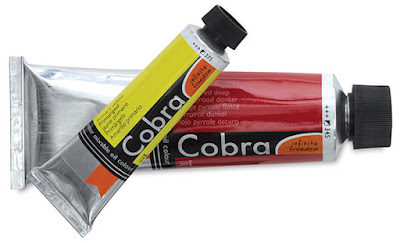
I recently read a blog about a way to clean up oil paints without using harmful solvents. While the advice was sound, my first thought was, "Why not just use water mixable oils and avoid solvents altogether?" But then I remembered my recent visit to a local art supply store to buy some water mixables. They didn't have any. I asked the clerk why they didn't carry them. She said they didn't carry them because they just don't sell.
Hmm. Why not? Why aren't artist buying these? In fact, why aren't artists demanding them? Why would anyone want to subject themselves to toxic, smelly chemical solvents if they don't have to? I started asking around and soon discovered that most artists who had ever tried water mixable oils had tried them around the time they were first introduced back in 1992 by Grumbacher as MAX water soluble oils. Artists were quickly disappointed and frustrated by their gummy, tacky properties. I myself tried them and was seriously disappointed, promptly returning to my traditional oils, stinky solvents and all.
Nothing against Grumbacher, mind you. They make fine products. It was just the technology of the time. There were no companies who had got it quite right yet back then.
But years passed and things changed. Water mixable oils have come a LONG way since 1992.
Seriously, if you have not tried them in the last several years you really should give them a second chance. I switched from regular oils to water mixables several years ago and I haven't looked back. There is almost no difference between the look and feel of regular oils and water mixables these days. The only thing you give up is the toxic solvent!
I've tried a few different brands. I quickly fell in love with Van Gogh H2O water mixables because of their soft, creamy texture. I paint fairly detailed and soft oils work better for me. I can paint fine detail without having to thin them much, if at all. Van Gogh H2O water mixable oils were produced by
Royal Talens and were considered "student grade" paints. I, however, was never disappointed in them. Nevertheless,
Royal Talens decided to discontinue them and replace them with "artist grade"
Cobra water mixable oils. I recently replaced some of my dwindling H2O paints with Cobra and I am just has happy as ever with them. They are wonderful! They have the same lovely creamy texture and beautifully rich colors as their H2O paints but now I know they are higher grade and that's just fine by me.
I have also tried
Winsor Newton's Artisan Water Mixable Oil Colours. It's a good product but a little too thick and stiff for me. It's harder to do the fine detail with a thicker paint.
I've also tried
Holbein Duo water mixable oils. This is also a good product and I use them with my Cobras sometimes. Their "thickness" is somewhere in between Artisan and Cobra.
I personally prefer Cobra among the 3, not because the others are not good products, but because the smooth creamy texture of Cobra works well for the sort of fine detail I like to do.
They are all very good paints, much better then their 1990-something predecessors. Which brand you'd prefer depends on how you paint. If you paint impasto then Artisan is probably your best choice. If you paint fine detail, like me, give Cobra a try. If you're somewhere in the middle then Holbein Duos may be your best option.
Whatever your style of painting, please take the time to give water mixable oils another chance. They have improved a LOT since they were first introduced. If you're like me, you'll be so happy to be away from smelly, toxic solvents and know you're doing a good thing for your health by switching!
Comment below with your thoughts. Have you ever tried water mixables? How long ago? Have you tried them recently? How do you paint (detail, impasto)? Which brands do you like best?




















